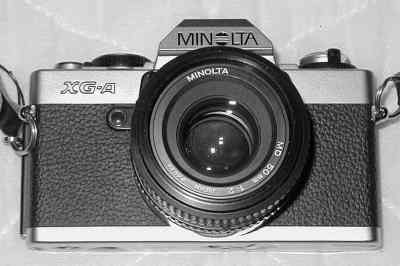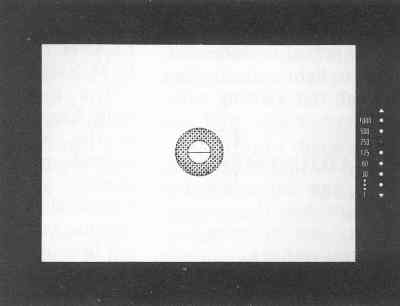

XG-A
(1981) In 1978, Minolta had introduced XG-1, a streamlined XG camera for photographers with limited funds. Then, in 1980, they introduced the X-7, a streamlined XG camera for photographers with simpler photographic needs. By 1981, Minolta realized that they could merge the two camera together -- and produced the XG-A. The XG-A is essentially the same camera as the XG-1, but without the manual exposure control. Or it is essentially the same camera as the X-7, but with fewer feratures. Take your pick. The body styling and shutter speed dial are the same as that of the X-7-- it is simplified and lacks the normal manual speeds. The dial retains the X and B settings, so that electronic flash can be used with non-X units (the camera automatically sets the shutter speed to X with X-style flash units), and time exposures can be taken. The camera allows adjustment of the exposure through the normal +/- 2 EV exposure compensation dial.
The viewfinder is almost exactly the same as the XG-1.
The speeds from 1/15 to 1 second are grouped together and represented
by a single LED. These are, after all, the speeds when you would need
a tripod -- an area that a neophyte would be best to avoid. By discouraging
use of this area, Minolta might be helping budding photographers get sharper
results. The only difference is that Minolta added the Acute-Matte screen
to the XG-A, which the XG-1 lacked. This makes
the viewfinder slightly brighter than that of the XG-1,
but it's not something of much importance to those seeking a simple, inexpensive
camera.

The XG-A is Minolta's simplest, auto-exposure SLR camera. Some would suggest it as the perfect first-time SLR, but the XG-A is not suited for those starting out in photography who will eventually want creative control. It is perfect for those who want the easiest to use camera -- but with interchangeable lenses -- AND who know that they will not want more control in the future.
Unfortunately for the XG-A, it had to compete against the XG-1 and X-7 cameras -- which Minolta still made -- as well as a myriad of "auto-everything" rangefinder cameras that were smaller and cheaper. The XG-A retained many features of the XG series, such as the Acute-Matte screen and the ability to accept a motor drive, even though these features were of no significance to the potential XG-A buyer. This kept the XG-A from being as inexpensive a camera as it could have been. Lack of advertising added to the problem. For a comparative look at the major features of the XG-A, check out MINMAN's SLR table -- the world's most complete!

RETURN TO THE MANUAL MINOLTA HOME PAGE
We didin't want to do this, but since other websites have been stealing our
stuff, we have no alternative but to state:
COPYRIGHT@1995-2023 by Joe McGloin.
All Rights Reserved. The material on this website is protected by US Federal copyright laws. It cannot be copied or used in any manner without specific approval from the owner.
The material on this website is protected by US Federal copyright laws. It cannot be copied or used in any manner without specific approval from the owner.